


Lakeside at Wonderland ...
A Living Example of Low Impact Development (LID)
A sustainable lifestyle community is an outcome of a design that focuses on increasing the efficiency of resource use — energy, water, and materials while reducing impacts on human health and the natural environment. Large portions of natural areas are protected in Open Space and developed areas have been designed to minimize impacts by incorporating Low Impact Development (LID) techniques for locating roads, homes, and other infrastructure like the management of stormwater.
Low Impact Development (LID)

A 7th Wonder of the World is the Gardens of Babylon that used pools and fountains for water management in a stunning and beautiful environment. The first and most famous of gardens is the Garden of Eden.
The primary goals of Low Impact Development are to first maximize protection of the natural environment (save the trees) and minimize the creation of impervious surfaces (less asphalt). Even the greenest developments clear land and create impervious surfaces. Mitigation of these impacts through proper management of the changes in stormwater runoff are accomplished in water sensitive landscapes—“Rain Gardens”. Use of Rain Gardens or Bio-cells also re-creates a more natural groundwater hydrology that allows a natural recharge of the local water features and aquifers.
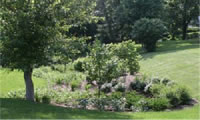
Today’s Rain-gardens are not as complex as the Water Gardens of Babylon but they are still aesthetically pleasing and extremely beneficial to the local hydrology and wildlife.
Lakes, streams, wetlands, and aquifers benefit from the natural water-cycle created in an aesthetically pleasing environment. From ancient cultures, the concepts of water gardens designed purely for pleasure first originated. Throughout history, mankind has been attracted to water in lakes, streams, pools, ponds, or fountains and often makes these essential components in ornamental gardens. The “water-garden” not only provides pleasure for people but also is essential for attracting and promoting use by wildlife.
For More information about LID

For more information about LID and building a Sustainable Healthy Lifestyle, please visit the Sustainable Lifestyle Campaign
Here is a link to the WSU Brochure on Rain Gardens
DOE Low Impact Development Technical Manual for the very serious.
Puget Sound Action Team brochure on LID
Prince George County, Maryland - the first county to promote use of LID to manage Stormwater in the 1990s.
Books, Posters, and Adopt-a-Stream
Here is a great link to raingardens. The booklet has lots of great information on building your own!
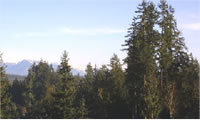
In a typical subdivision, tall firs like these would be cut down and the plat would be named “Tall Firs”. --- LID preserves these resources with careful design around the natural environment.
Use of LID practices and technology do require investment of additional time and money in the initial planning stage. In depth site analysis of the existing natural environment is needed to locate significant trees and other natural features such as above and below ground drainage features. Instead of designing some simple grid system layout on a flat piece of paper, a proper LID design needs to merge into the natural 3D environment given.
The upfront investment of additional time and money is recouped in the benefits of creating a sustainable-livable community for all that are fortunate enough to live in these environments.
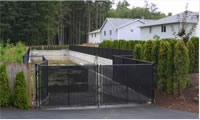
The conventional “Convey and Collect” Stormwater Management system is not only unappealing but it degrades the environment by disrupting the natural water cycle. These “dead-storage” pools become breeding grounds for mosquitoes which increases exposure to West Nile Virus.
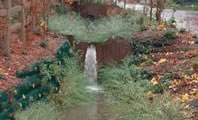
Conventional storm water management systems rely on collection and conveyance systems in an attempt to remove water safely from developed areas to protect life, property and health. The results are the opposite. The use of “detention prisons” is ineffective in treating of polluted runoff and creates unhealthy breeding areas for mosquitoes (source of West Nile Virus). All the water that is collected and conveyed from the area of development is now concentrated at a single point for discharge. Natural hydrologies to water-features are compromised by depleting natural recharge of local stream segments, wetlands, and aquifers. Often several watercourse segments are dried up while others are overcharged creating erosion and flooding.
LID stormwater management uses simple techniques to make a real difference in the way runoff is managed throughout the landscape. In a natural environment, rain typically falls on vegetation and is dispersed over a broad area before it is exposed to the ground on its journey through the natural water-cycle. An LID system re-creates this effect by use of the landscape and soils to naturally move, store, and filter un-concentrated flows from impervious surfaces. The LID system allows for the natural re-charge of all local surface and ground water systems. There are many benefits to this system besides maintaining the natural hydro-cycle; wildlife benefits from the bio-diversity; water-gardens provide visual benefits to the living environment; and they create a total ecological micro-system that provides long-term environmental benefits to the world in which we live.
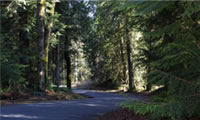
LID roads provide for circulation but are merged into the existing environment like this road into Lakeside.
New designs for streets, driveways, and pathways maintain functional circulation while reducing expansive impervious surfaces that can alter or degrade water quality.
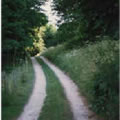
A country-lane back to a home offset from the road.
Instead of wide expanses of pavement that typically provide for travel, parking, and pedestrian circulation; separated pervious paths and pervious shoulder areas provide safe pullout and walking features. Separated pedestrian facilities not only provide safer use but they provide a far more enjoyable walking environment merged within the natural environment.
Private access roads to the clustered homesites are designed to meander around significant trees creating a unique and visually pleasing drive to your home. Longer setback driveways have the country lane appearance from road to home.